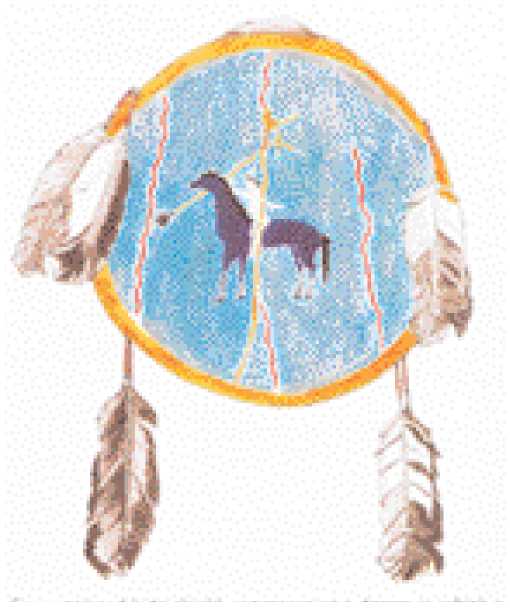The discovery of gold in the Black Hills of Wyoming and South Dakota in the year 1874 led to the next phase of the Sioux Wars: the War for the Black Hills (or Sitting
Bull and Crazy Horse’s War) of 1876—77. By now, Red Cloud and Spotted Tail had settled on reservations. Sitting Bull and Crazy Horse now led the allied hunting bands that refused to give up the traditional nomadic way of life. Opposing them were two generals who had become famous as Union commanders in the Civil War, General William Tecumseh Sherman, overall commander of the army, and General Philip Henry Sheridan, commander of the Division of the Missouri. In the field, the generals had various officers, including General George Crook, who had previously fought APACHE and PAIUTE, and Lieutenant Colonel George Armstrong Custer, who had earlier campaigned against the Cheyenne.
War broke out when the military ordered the hunting bands onto the reservation. When the bands failed to report, the army went after them in the winter of 1876. During that year, some of the most famous battles on the Great Plains took place. The first three were great Indian victories. The final five were victories for the army and brought the resistance of the Sioux, Northern Cheyenne, and Northern Arapaho to a virtual close.
At Powder River in Montana in March 1876, Oglala and Northern Cheyenne warriors under Crazy Horse repelled a cavalry attack led by Colonel Joseph Reynolds. At Rosebud Creek in June, Crazy Horse’s warriors routed General George Crook’s huge force of soldiers and their CROW and SHOSHONE allies. Then also in June, along the Little Bighorn River, Oglala under Crazy Horse and Hunkpapa under Sitting Bull and Gall, plus their Cheyenne allies, wiped out Custer’s Seventh Cavalry.
The Battle of Little Bighorn is the most famous battle in all the Indian wars. It is also called Custer’s Last Stand or the Battle of Greasy Grass. George Armstrong Custer was a vain, ambitious, and impulsive young cavalry officer, called “Long Hair” by the Indians because of his long blond locks. He was trying to use the Indian wars as a means to further his own career. Although he had had success as a Union officer in the Civil War, his only victory to date in the Indian wars had been against Black Kettle’s peaceful band of Southern Cheyenne in the Indian Territory (present-day Oklahoma) in 1868. He brashly underestimated his opponents.
When his scouts spotted the Indian camp along the Little Bighorn, rather than wait for reinforcements under General Alfred Terry and Colonel John Gibbon, Custer divided his men into four groups and ordered an attack. In a series of separate actions against the divided force, the Indians managed to kill at least 250 soldiers,

Sioux painted hide shield, representing a dream in which a warrior rides Thunder Horse in a contest with Turtle
Including Custer’s entire detachment and the lieutenant colonel himself.
This was the last great Indian victory on the Plains. The following battles proved disastrous for the Sioux and their allies. In July 1876, at War Bonnet Creek in Nebraska, a force under Colonel Wesley Merritt intercepted and defeated about 1,000 Northern Cheyenne, who were on their way to join up with Sitting Bull and Crazy Horse. In September 1876, at Slim Buttes in South Dakota, General Crook’s advance guard captured American Horse’s combined Oglala and Miniconjou band. In November 1876, in the Battle of Dull Knife in Wyoming, Colonel Ranald Mackenzie’s troops routed Dull Knife’s band of Northern Cheyenne. In January 1877, at Wolf Mountain in Montana, General Nelson Miles’s soldiers defeated Crazy Horse’s warriors. Then in May 1877, in the Battle of Lame Deer, General Miles’s men defeated Lame Deer’s Miniconjou band.
Crazy Horse died in 1877, stabbed with a bayonet while trying to escape from prison. Although photographs exist of other Native American from this period of history, there are none of Crazy Horse. He refused to pose for photographers, saying, “Why would you wish to shorten my life by taking my shadow from me.” Sitting Bull and some of his followers hid out in Canada until 1881, when he returned to the United States to surrender. He went on to play a role in events leading up to the famous Wounded Knee incident.
The power of the northern plains tribes had been broken. The southern and central Plains Indians—the Comanche, Kiowa, Southern Cheyenne, and Southern Arapaho—had previously yielded. Other Indian tribes to the west of the Rocky Mountains—such as the Apache, NEZ PERCE, UTE, and BANNOCK—would continue their resistance for some years, but the Indian wars were winding down. The final Apache rebellion, under Geronimo, ended in 1886.




 World History
World History









